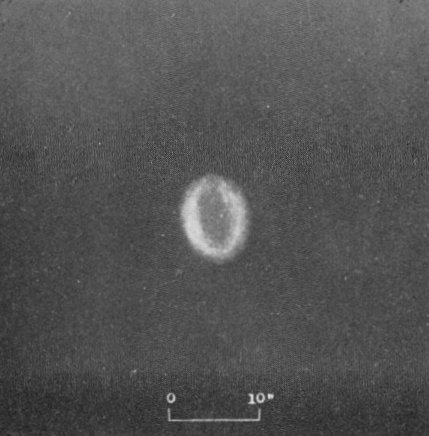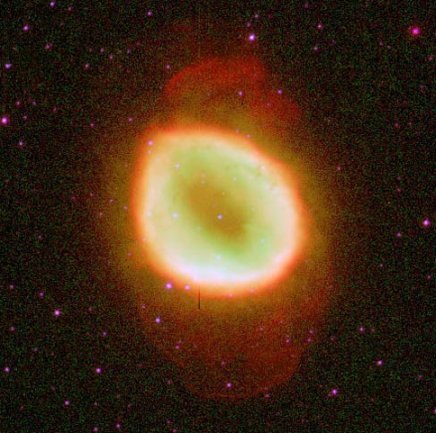NGC 6565
Curtis, from a century ago: "No central star can be seen. A minute
oval ring...Fairly bright." Rotate the Hubble view on the right by
about 35 degrees clockwise to align it with Curtis's picture.
Embraced by the great Sagittarius star
clouds, NGC 6565, just nine seconds of arc across, is at the
northern apex of an equilateral triangle formed with Gamma and Delta
Sagittarii, roughly 2.5 degrees from each. A typical fainter
outer halo appears on the Hubble image. Though the distance is not
really known, there seems to be some consensus that the nebula is
far away, perhaps as much as 15,000 light years (giving it a highly
uncertain diameter of 0.65 light years). Only six degrees from the
direction to the Galactic center, it's
roughly halfway to the Galaxy's actual central core
(where we find the supermassive black hole of four million
solar masses). The nebula is widely thought to be a part of the
Galaxy's central bulge. Yet visual dimming by interstellar dust is fairly low,
less than a magnitude, revealing a relatively clear tunnel through
the haze (or that it is a lot closer than we think). One measure
suggests that helium may be enriched in the nebula by a dubious 40
percent, while the nitrogen content appears more or less
normal.
It's no wonder that Curtis could not see the central star, as it's
so faint, eighteenth magnitude. The nebular background makes it
even more difficult, though NGC 6565's center is "relatively
vacant." A measured visual magnitude of 17.8 compared with nebular
radiation (which responds to the stellar ultraviolet) gives a stellar
temperature of 105,000 Kelvin and a luminosity that (depending
strongly on distance) is somewhere in the hundreds of Suns. The star, with a relatively low mass of
somewhat over half a Sun, appears to be near its turnaround point
where it stops heating at a constant temperature and begins to cool
to become a real white dwarf. Expanding at 15 to 20 kilometers per
second, the planetary nebula will at the same time fade into the
cosmic gloom, carrying with it another load of matter with which to
build new stars and perhaps a bit of extra helium.
Left: Image and quote by H. D. Curtis from Publications of the Lick
Observatory, Volume 13, Part III, 1918. Right: Hubble Legacy
Archives, A. Hajian et al.



